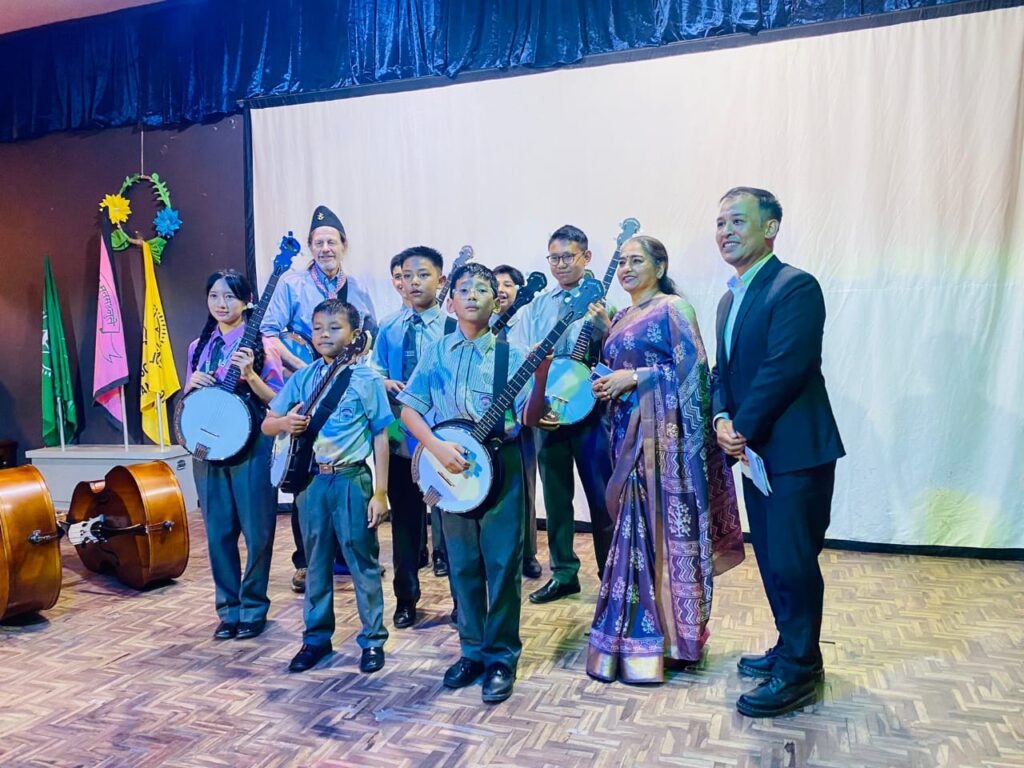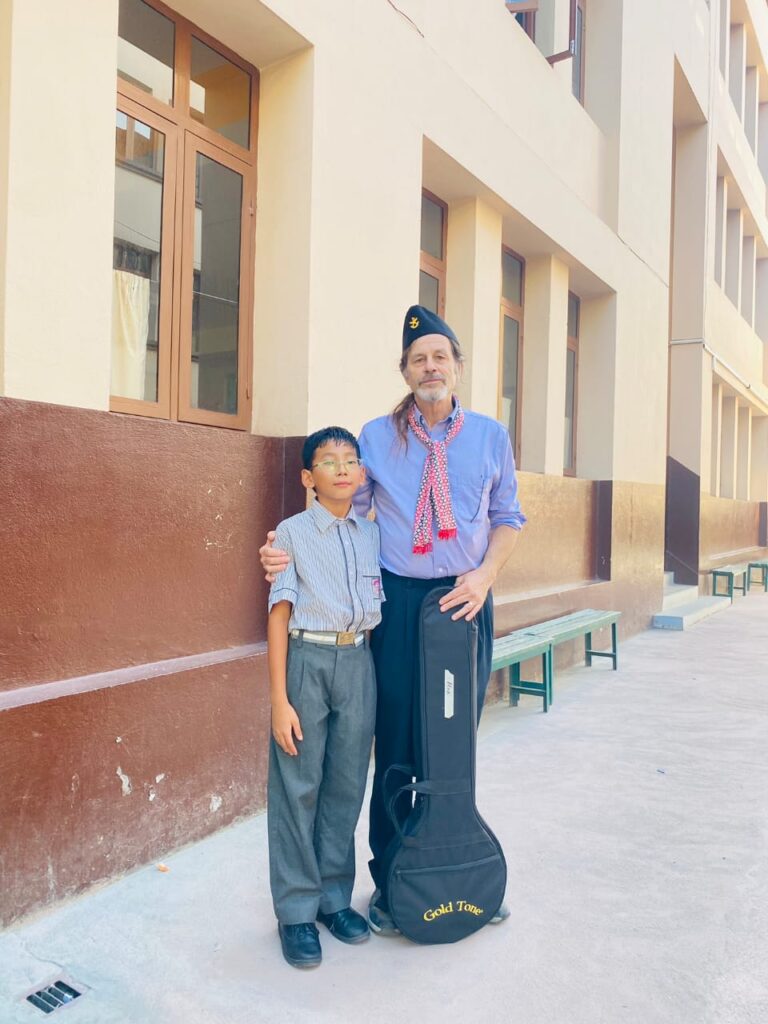The Tennessee Bluegrass Band was the headliner for the first day of the 32nd annual East Troy Bluegrass Festival.
East Troy Festival Caps a Great Summer
The start of fall always brings the melancholy reflection that bluegrass festival season is practically at an end.
But at least those of us who managed to get out and about this summer have some pleasant memories to look back on. Alongside the many, many wonderful festivals held in other parts of Wisconsin and the rest of the Midwest this summer, there were some notable ones in our corner of the state.
Unfortunately, one of these — the Pioneer Village Bluegrass Festival — took place the day after torrential rains caused flooding in Milwaukee and its environs. I was one of the no doubt dozens of bluegrass fans who were kept away from the performances that day by police blockades and closed roads.

East Troy Bluegrass Festival on Sept. 13.
But our member emeritus, Linda Sandersen, did manage to attend. You can read her report on the goings-on at Pioneer Village on the following page.
I did get out to one of the other highlights of the festival season — the East Troy Bluegrass Festival. This year, this fixture of the bluegrass calendar featured three headlining acts, Steam Machine, The Tennessee Bluegrass Band and Southern Legacy, along with various other bands from southern Wisconsin and nearby places.
Now in its 32nd year, this event has never been one to disappoint. This time was no exception. A hearty thank you goes out to everyone who helps make possible this event and all the other festivals that enliven our summers.
All this of course has us thinking of our own big annual show: The Big Thaw. Always held in the spring, it’s on the calendar next year for March 21. (We moved it up a bit to decrease the likelihood that we’ll have to compete with good weather.)
As we make our plans, we know that the standards set by other regional festivals are high. We’re working on the lineup and would love to hear from
you about any bands that should perhaps be added.
Speaking of bands, we’re also working hard to keep up to date our weekly calendar listings showing who’s playing where. Please give us a hand by sending in your performance schedules to badgerlandbluegrass@gmail.com.
As always, thank you for your support and keep on picking.
— Dan Shaw, BBMA vice president
Bluegrass at Pioneer Village

It was a rainy day and the ride to Pioneer Village took one and a half hours instead of the normal 45 minutes because of accidents and closed roads.
Still, we were early. The stage was moved inside the “village hall” to accommodate the expected reduced audience. Everyone was in good spirits and everyone was enjoying the first act, Jake & Mikayla, a group out of central Illinois. They have good harmonies and a good backup band.
They were followed by The Henhouse Prowlers (who were on again as the last band). The Prowlers are also out of Illinois and have traveled the world as the “ambassadors of bluegrass”. They are rock-solid performers with excellent harmonies and strong instrumentation. They have been performing as a band for 17 years and have released many CDs with their signature harmonies and classic tradition.
Pickin’ Up Speed played as a trio, with Linda and Poul Sandersen and Ron Wedekind, since Jerry Smith (mandolin) was bailing out his basement recreation room, which had been inundated with 19 inches of rain from the storm the day before. It was the group’s final performance, disbanding after 23 years together. Pickin’ Up Speed has five albums. If you’d like one, please let us know by sending an email to Lsandersen@wi.rr.com.
We’ll still be organizing the BBMA jams, moving to Newcastle Place, 12600 N. Port Washington Road, Mequon, on the second Sunday of the month from 1:30 p.m. to 4:00 p.m. in the community room.
Cerny and Ogburn, masters of their craft on guitar and mandolin, were joined by Viktor and Kristian Brusubardis on fiddle and cello. Luke’s tenor vocals, joined by Ryan’s harmonies, gave us a joyful high-energy performance. We’re looking forward to seeing them again, too!
The festival also included jamming in the Hashek barn, dulcimer lessons, ukulele lessons, a kids’ corner with crafts, as well as a flatpickin’ class with Luke Cerny. What a day! Rain and drizzle didn’t stop anyone from having a wonderful time!
How I Spent My Summer Vacation in Kathmandu
Last May I had an unusual and remarkable opportunity: to go to Kathmandu, Nepal, and teach bluegrass banjo at a private high school! As a banjo player, how could I turn down such an offer? So my partners and I spent eight weeks at Triyog High School as teachers in the Bluegrass Academy. We taught banjo, fiddle, guitar, mandolin and a little bit of bass to 27 students, ages 10-14.

Bluegrass Academy in Kathmandu, Nepal.
The Academy was an intensive after-school music program, requiring two hours a day, five days a week. That meant long days for the students, yet they showed up ready to learn and most of them grasped the basics of their instruments quickly. For me, the enthusiasm of the students and watching them take to the music so quickly was one of the most gratifying parts of the adventure.
The students were also eager to share their music with us teachers. Many of them played other instruments, such as guitar, piano and violin. They would play for us or show us videos of everything from Nepali pop tunes, folk songs and Western popular music. Here’s a link to a song by the popular Nepali band, “Albatross,” that the kids played for me: https://www.youtube.com/watch?v=O3F4q8RkI68. It also turns out that “Thunderstruck” by AC/DC and anything by Metallica were also quite popular. Who knew?
Nepal has a rich tradition of mountain music, just like we do in the States. It’s called gandarba and the players are called “gandarbas.” It is a tradition that goes back a least a thousand years and continues to this day. In some ways, gandarba is like the original minstrel music of the British Isles: the players go from town to town to earn their keep, ensuring the music remains alive and bringing news to remote areas. It seemed to me that playing gandarba and living the gandarba life is a calling as much as a way to earn a living.

student in Kathmandu.
It was also my great pleasure to meet Anil Gandarba, who is a fourth or fifth generation player (he’s not sure how far back it goes!). He is considered one of the top sarangai (Nepali fiddle) players in Nepal. Like all the musicians I met, he was very gracious and happy to share his music and background. I learned that gandarba doesn’t sound all that strange to my hillbilly ears. It’s mostly major pentatonic music and uses common times like 3/4, 4/4 and 6/8. As an example, here’s Anil’s band, the Samundra Band playing Cripple Creek: https://youtu.be/vaAZ77tooB4. Here’s another link to a classic Nepali folksong, “Resham Firiri.” It has captions, so sing along: https://www.youtube.com/watch?v=vl7g0p0tHLM
By the way, there will be teaching opportunities in the near future. If you’re interested in the program or just a little curious, check out The Bluegrass Journeymen website. This is the organization that made the program possible and has connections throughout Nepal and India. They are great folks and are dedicated to spreading Bluegrass in the subcontinent https://www.thebluegrassjourneymen.com/
When you’re from Twin Lakes, Wisconsin, Kathmandu is a very exotic place. It was a fascinating experience and this brief article just skims the surface of music in Kathmandu. Next time you’re over my way, come on over and I’ll show you my slides and tell you about the Gypsy Jazz scene, the reggae band in Thamel or the time I played the blues at the Hardrock Cafe. The point is, it’s all there in Kathmandu and it leads to wonderful experiences. If you ever get the chance, go!
— Max Winkels is the treasuer of the BBMA.

